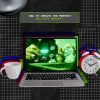Why Most Ecommerce Brands Misread ‘Low Traffic’ Product Pages (And How Smart SEO Agencies Fix It)
Dec 23, 2025

Dec 23, 2025

Dec 23, 2025

Dec 23, 2025

Dec 22, 2025

Dec 22, 2025

Dec 22, 2025

Dec 22, 2025

Dec 22, 2025
Sorry, but nothing matched your search "". Please try again with some different keywords.


Training a student in a specific subject can take place in different forms. It is important to acquire in-depth knowledge through practical research in addition to studying theoretical foundations.
This is an important part of the educational program at schools and higher education institutions. A research project is a paper a student prepares independently on a predetermined topic. Research work is prepared for presentation at a conference or certification event and often involves grading.
The requirements for what should be included in a research paper are provided by the educational institutions, so their compliance is strictly checked when accepting a research paper for defense. For those who have difficulties in meeting all the requirements, we offer the best site to buy research paper. Writers who work there stick to all customers’ instructions while writing papers.
Now, let’s find out what you should include in your research paper about social media’s effects on society.
Here is a brief overview of the research work done. Existing rules require the introduction to raise issues and define goals, hypotheses, and objectives, providing a rationale for research.
The study’s author must demonstrate the scientific and practical significance of the chosen topic. It can be done in the following way:
Example:
“Relevance and choice of research topic
A few months ago, I registered on the social network Facebook. In addition, I know that many of my classmates are also registered on various social networks, and some of them spend a significant part of their time on their pages.
The relevance of the topic of my research work lies in the fact that more and more people, including children, register on social networks and spend a lot of time there. Therefore, I decided to find out whether we spend time on our pages on social networks with benefits or without them and learn the positive and negative effects of social media.”
A hypothesis is the assumption formulated by the author of the paper. In the future, in the course of the research, they must prove the truth or falsehood of their version. The confirmation should be the results of experiments or theoretical research.
Example:
“Research hypothesis: Let’s assume that social networks are a very interesting, educational activity for society that does not cause harm.”
The author of the research paper must indicate the result that they strive for when performing the work. This will be the goal. The tasks are included in the form of a step-by-step algorithm. An improperly formulated task may resemble a plan for preparing the research paper, but research should be conducted and hypotheses tested before writing the paper.
Example:
“Goals:
The following tasks follow from the set goals:
It’s crucial to differentiate between these two ideas:
Example:
“An object of research: social networks.
A subject of research: the influence of social networks on society.”
This term refers to the methodology used to study the subject. Depending on the specific object and purpose, options for obtaining the necessary information change.
Example:
“Research methods: observation, questionnaires, study of literature, Internet sources.”
The designated topic is fully revealed here.
The first chapter of the study reviews the literature used, including the reasons for choosing these sources, their relevance, and significance.
You can start this chapter in the following way:
“Using Wikipedia data, I learned that a social network is a site designed for people to communicate and exchange information between them.”
Here, the author describes the work done, analyzes third-party methods and results, compares them with their own, and builds an argumentative basis for formulating conclusions. For experimental work, a detailed description of the issue being studied and the effectiveness of the applied solutions may be required. Traditionally, the main part contains various illustrative materials – graphs, charts, and diagrams.
You can start the following chapters in this way:
“I developed questionnaires (Appendix 3), which helped me find out the number of people registered on social networks and attitudes towards them. People of different ages were selected for the survey. Twenty-nine people took part in the survey. After processing answers, I received the results that are presented in Appendix 4.”
Here, a summary of the research is presented:
Example:
“During the research work, the hypothesis that social networks do not cause harm was not confirmed.
Also during the study:
I confirmed in practice that life without social media is not only possible but also useful and interesting. This experience was exhilarating and useful for me. It made me think about how we sometimes waste our time in vain.”
More Resources:
Barsha is a seasoned digital marketing writer with a focus on SEO, content marketing, and conversion-driven copy. With 7 years of experience in crafting high-performing content for startups, agencies, and established brands, Barsha brings strategic insight and storytelling together to drive online growth. When not writing, Barsha spends time obsessing over conspiracy theories, the latest Google algorithm changes, and content trends.
View all Posts
Why Most Ecommerce Brands Misread ‘Low Traf...
Dec 23, 2025
Twitter Marketing: How To Promote & Engag...
Dec 23, 2025
Reporting SEO: How To Create The Perfect SE...
Dec 23, 2025
Guide To Agile Certification Courses At Itsm ...
Dec 22, 2025
Why SimRigs Turn-Key Racing Simulators Are th...
Dec 22, 2025

